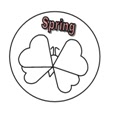Students must first of all understand what a picture graph is. A pictorial or picture graph uses pictures to represent numerical facts. Sometimes it is referred to as a representational graph. Each symbol or picture used on the graph represents a unit decided by the student or teacher. Each symbol could represent one, two, or whatever number you want. This type of graph is used when the data being gathered is small or approximate figures are being used, and you want to make simple comparisons.
Here is what you do to make ready-made picture graph stencils.
- Choose the size of lid that you want and turn it over. Then trace a pattern on the plastic lid. Make sure you are using the bottom of the lid so the rim does not interfere when the children use it to trace.
- To make the stencil, cut out the pattern using an Exacto knife. You might choose to do zoo animals: a zebra, a lion, a bear, an elephant or a giraffe.
- Have a large sheet of paper ready with a question on it such as: “What is your favorite zoo animal?”
- The students then select the stencil (picture) that is their favorite animal and trace it in the correct row on the graph.
You could craft stencils for modes of transportation, geometric shapes, pets, weather, etc. The list is infinite. But what if you don't want to or don't have time to make all of those stencils? Then save the strips that are left when you punch out shapes using a die press. They are instant stencils!
If you are interested in additional graphing ideas, check out the resource entitled: Graphing Without Paper or Pencil. You might also like Milk Lid Math. This four page handout contains numerous math activities that utilize a free manipulative.


